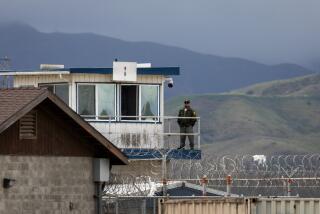D.A. candidates must be clear on where they stand on three-strikes
Los Angeles County Dist. Atty. Steve Cooley’s three-strikes policy is often articulated simply — and wrongly — as follows: He won’t seek a life sentence against a third-time convict unless that third strike is serious or violent. If that were in fact his policy, it would prevent life sentences for petty drug crimes and other nonviolent acts — and it is in essence what is being proposed in an initiative cleared for circulation that California voters may see on their Nov. 6 ballot.
Cooley’s actual policy encompasses more nuance and leaves prosecutors a bit more discretion. Unless the potential third strike is for a serious or violent felony, Cooley will treat it as a second strike for which the prison sentence is doubled — except in unusual circumstances, when he will go ahead and seek a life term. How unusual? He has a team that examines the defendant’s record to determine whether too short a sentence is likely to pose a danger to society or otherwise work an injustice. Just how heinous, for example, were the crimes that made up the first two strikes?
For his independence and resolve, Cooley was shunned by his 57 fellow California district attorneys. Most now employ his approach, although few will admit it, and none will put it in writing as Cooley has.
Either the Cooley model or the more sweeping reform is preferable to the draconian way the law is still enforced in some other counties: After two violent or serious felonies, a third strike is a third strike and carries with it a 25-years-to-life sentence, even if that third conviction was for trying, and failing, to swipe a corn dog off a picnic table. That dumb-on-crime approach may be what a pandering Legislature and panicking voters had in mind when they adopted three strikes, twice, in 1994, although there is little evidence to tie the law to a drop in crime that began three years earlier. With three strikes in place, crime rose gain — and then dropped again.
Meanwhile, three strikes helped fill California prisons not merely with the dangerous felons who need to be there, but also with feckless addicts and the mentally ill who need to be treated, trained and tracked — and, when necessary, jailed locally.
And what about the six candidates in the race to succeed Cooley? Do they agree with his rational take on three strikes? Will any of them be bold enough to back the ballot proposal, or an even more sweeping revamp of three strikes? Or will they fall back on typical election-year tough-on-crime promises? Voters deserve straight talk from the candidates about where they stand, about what they believe — and about which policies keep Los Angeles County residents safe, and which ones merely cater to their fears.
More to Read
A cure for the common opinion
Get thought-provoking perspectives with our weekly newsletter.
You may occasionally receive promotional content from the Los Angeles Times.










